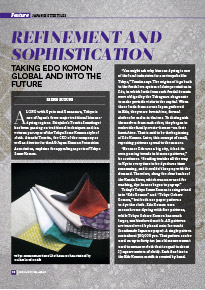Home > Highlighting JAPAN >Highlighting Japan January 2015>Japanese Textiles
Highlighting JAPAN

Japanese Textiles
Refinement and Sophistication
Taking Edo Komon global and into the future

Along with Kyoto and Kanazawa, Tokyo is one of Japan’s three major traditional kimono-dyeing regions. Shinjuku’s Tomita Somekogei has been passing on traditional techniques and is a veteran purveyor of the Tokyo Some Komon style of cloth. Atsushi Tomita, the CEO of the company as well as director for the All-Japan Kimono Promotion Association, explains the appealing aspects of Tokyo Some Komon.
“You might ask why kimono dyeing is one of the local industries for a metropolis like Tokyo,” Tomita says. The origins of it go back to the feudal era system of daimyo rotation in Edo, in which lords from each feudal domain were obliged by the Tokugawa shogunate to make periodic visits to the capital. When these lords from across Japan gathered in Edo, they wore kamishimo, formal clothes for males in that era. To distinguish themselves from each other, they began to embroider family crests—komon—on their kamishimo. That is said to be the beginning of Edo Komon. Later, this concept of small, repeating patterns spread to the masses.
“Because Edo was a big city, it had its own passing trends in kimono patterns,” he continues. “Sending textiles all the way to Kyoto everytime to be dyed was time consuming, and it couldn’t keep up with the demand. Therefore, along the clear banks of the Kanda River, which was once used for washing, dye houses began to pop up.”
Today’s Tokyo Some Komon is categorized into “Edo Komon” and “Tokyo Oshare Komon,” but both use paper patterns to dye the cloth. Edo Komon uses monochrome dyeing with fine patterns, while Tokyo Oshare Komon has much larger, multicolored motifs. All patterns are transferred by hand onto Ise washi (handmade Japanese paper). A single pattern costs about 300,000 yen. That pattern can be used on up to forty tan (an old measurement used to measure cloth that is equal to about 23 square meters of cloth). Each fine line in the Edo Komon motifs is created by hand. This technique is also believed to have had a major influence on textile printmaking in modern Europe and America.
Tokyo Some Komon starts off with a white cloth placed atop a long board, and the paper pattern is put on top with the dye being placed over that. The areas left in relief absorb the dye. After the dye is smeared across the cloth using a spatula, the cloth is steamed to develop the colors. Once the paste is washed off, the beautiful Edo Komon reveals itself. The cloth is dried, its wrinkles are smoothed out using steam, and the figure is fixed. After some final color adjustments, the Edo Komon is complete.
“Beyond these Tokyo Some Komon patterns, there are numerous amazing handicrafts in Japan,” says Tomita. “However, even among Japanese women, the number of people who still know how to dress themselves in a kimono is under ten percent. No matter how much the craftspeople think these are excellent articles worth creating, if people do not use them, they remain confined to the realm of traditional crafts.” Seeking to avoid being beaten out by contemporary mass production, Tomita is hatching plans to use traditional techniques to create whatever products the clients seek.
This is already in practice at Tomita Somekogei, where Tokyo Oshare Komon patterns are used to dye various materials such as silk and wool to make scarves and stoles. Combining Japan’s finest textiles with traditional dyeing thus creates contemporary, luxury cloths with traditional motifs. These are sold at department stores like Mitsukoshi and Takashimaya, and have been exhibited at Maison et Objet in Paris as well. The collection also drew attention at Takashimaya Singapore in spring 2014.
Just putting something on a shelf as “an item from the past” sentences it to being a craft good. Tomita says that staying relevant in the marketplace and meeting shoppers’ needs is essential if these traditions are to be passed along to the next generation.
What triggered the company’s idea to promote contemporary items made with traditional means was a project held in 2012 following the Tokyo Metropolitan Art Museum’s reopening. The museum invited contemporary designers and artists to collaborate on a new proposal, and the winning project, “Komon chief,” (a type of handkerchief) involved pocket squares featuring Edo Komon motifs. It was here that Tomita realized that by doing away with conventional ideas, they could create something modern that breathes new life into the styles of Edo.
Old Edo held that refinement lay not in obvious, showy adornment, but that style is kept hidden. Tomita shared his enthusiastic vision for the future, saying, “We want to share that sense of style overseas through Tokyo Some Komon textiles.”
© 2009 Cabinet Office, Government of Japan






